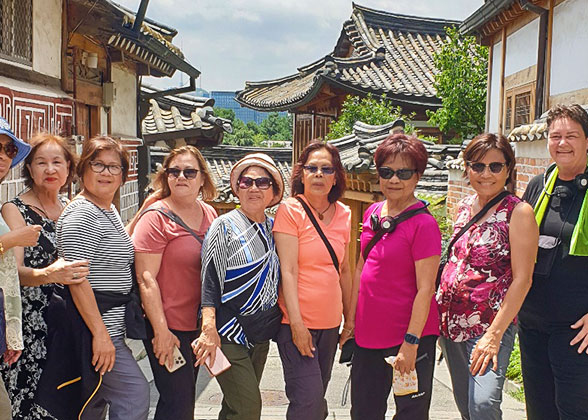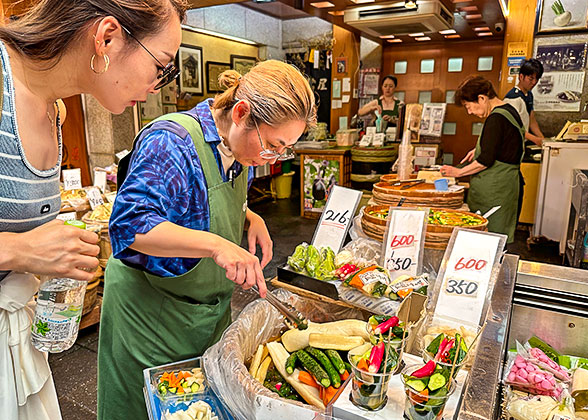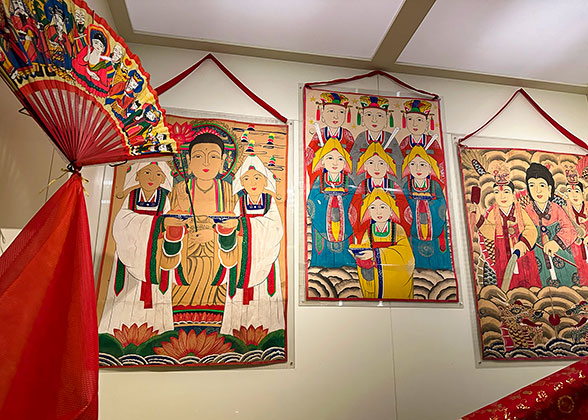Day 1: Arrival in Seoul, Airport Pick-up
Welcome to Seoul! After arriving at Incheon International Airport, you will be warmly picked up by a private chauffeur and transferred to the well-selected hotel in downtown Seoul by a 1.5-hour drive.
► Recommendations for Early Arrivals
For the rest of the day after checking in at the hotel, you could spend some time resting and adjusting to the time difference, or go out to explore the nearby streets by yourself. Walk northeast for 10 minutes from your hotel to Myeongdong Shopping District, one of the liveliest areas in Seoul. Here you could find international and designer brands, fashion clothing, accessories and cuisine, as well as loads of Korean items like snacks, drinks and K-Beauty products. Try some authentic local food like Korean-style fried chicken and BBQ.
► Wi-Fi or SIM Card?
South Korea has one of the best network coverage in the world, with free Wi-Fi offered in public places, cafes, bus stops, and train and subway stations in most cities. If you are traveling solo, you could decide whether to buy a SIM card based on your needs. In most areas of Seoul, there is free Wi-Fi available for you to stay connected, but in some less-touristy places of Jeju Island, it might be a challenge to find a free Wi-Fi with good network, and it’s a good choice to purchase a SIM card at the airport. If you are traveling with your family or friends, renting a pocket Wi-Fi is another option for you all to get connected simultaneously, and the cost is lower.
► Money Exchange
Most stores, supermarkets and restaurants in South Korea support card payment, but carrying some cash can be more convenient when you buy street food or small items. Avoid exchanging money at the airport because you may face bad rates or commissions. You could find a WOWPASS money exchange machine in downtown to get some Korean won at the best exchange rate.
Accommodation: Fraser Place Namdaemun Seoul (4 stars) or similar
|
Day 2: Seoul Sightseeing with Gyeongbokgung Palace, Insadong & Bukchon Hanok Village; Fly to Jeju Island
After breakfast, your English-speaking driver guide will meet you at the hotel, and then escort you to Gyeongbokgung Palace. First built in 1395, it used to be the royal palace of the Joseon Dynasty (1392-1910), with over 500 buildings giving the feeling of aesthetics and grandeur. However, due to several fires and Imjin War (1592-1598), only 10 of the original buildings are well-preserved. Stroll around the spacious palace and step back in ancient time. Stand by the old cyan halls and pavilions, and feel the breath of history and the charm of the architecture. You’ll have the chance to witness the Guard Changing Ceremony, which aims to recreate the practice of the ancient times. Also spend some time at National Folk Museum inside the palace. Gain some knowledge about the life and customs of Koreans past and present through the cultural relics like ancient costumes and vehicles on display.
► Tip: The palace closes on Tuesdays, and we will go to Changdeokgung Palace as a replacement in that case.
Next, let’s walk along Insadong Antique Alley and get beguiled by the exotic sentiment and artistic atmosphere. The streets are brimming with about 100 galleries as well as stores selling traditional handicrafts and artworks. Take a stroll and appreciate the fine antiques and paintings, or drink a cup of coffee and savor some street food. Next, discover the wonders of Korean’s food culture at Museum Kimchikan, which is listed as one of the “World’s Top 11 Food Museums” by CNN. Kimchi, Korea’s traditional fermented vegetables with tangy flavor and crunchy taste, must be a representative one when it comes to Korean food. You may have noticed that most of the Korean restaurants offer free kimchi as side dishes. But surprisingly, due to the soaring prices of ingredients in South Korea, about half of the kimchi served in the restaurants are imported from China. Follow the guide to learn about the process, eating methods, and different types of kimchi. Watch how the red, yellow and green cabbages or radishes are stored inside the jars, and even listen to the soft sound of the lactic acid bacteria and enzyme during fermentation.
Later, we’ll continue to visit Bukchon Hanok Village. The village was once the residential area of the officials and nobles 600 years ago, with more than 900 traditional hanok houses well-kept in the midst of bustling downtown Seoul. There are still residents living in Bukchon, and some of the old houses have been transformed into Hanbok rental stores, craft workshops and restaurants, adding the beauty of modernization and vitality to the peaceful ambience. Please try not to disturb the life of local residents, and do not take photos of the interior of their private houses.
► Tip: If time permits, it is strongly recommended to rent a set of hanbok clothes at your own expense to immerse yourself into the Korean culture. Hanbok is the traditional clothing of people in the Joseon Dynasty. Typically, both men’s and women’s hanbok are bright-colored with loose, graceful design for ease of movement. Be a Joseon prince or princess yourself, and take some dreamy photos in the nostalgic background of hanok houses.
By the end of the day, you’ll be transferred to the airport for your flight to Jeju Island, the so-called “Oriental Hawaii”. Upon arrival, the local driver will pick you up and transfer you to check in at the hotel. Have a good rest to prepare for the coming Jeju Island tour.
Meals: Breakfast
Accommodation: Hotel Sirius, Jeju (4 stars) or similar
|
Day 3: Jeju: Visit Seongeup Folk Village, Seongsan Sunrise Peak, Jeju Haenyeo Museum, Woljeongri Beach
This morning, wake up in the picturesque views of Jeju, and follow the guide to start your island exploration from Seongeup Folk Village, where you can learn about the real life style of the local fishers. The village has the largest number of thatch-roofed houses on this volcanic island. What you see in the village is almost the same as it was 600 years ago. As the shooting site of the well-known TV series “Jewel in the Palace”, it captivates numerous visitors to take wedding photos or hanbok photos. There are many lava rock statues in the village which are called “Dolharubang” or “Grandfathers of Jeju”. They have distinctive expressions and are said to bring good fortune to those who touch them.
Next, let’s climb up to the world’s largest coastal crater on Seongsan Sunrise Peak. This iconic tuff volcano was formed by a submarine volcanic eruption 5,000 years ago. It stands 182 meters (597 ft.) high above sea level, with a huge green-blanketed crater that has a diameter of about 600 meters (1968 ft.) and a depth of 90 meters (295 ft.). Overlook the blue sea and enjoy the striking view of the coastline from the rim of the crater. Also you may have the chance to witness a Haenyeo Women Diver Performance offshore. Afterwards, pay a visit to Seopjikoji Cape, a coastal trail with delightful scenery. In the background of Seongsan Sunrise Peak, Seopjikoji offers a wide field of vision with black sandy beach and vast grassland. Walking along the stone-paved path, listen to the sound of the white breaking waves beating against the black volcanic rock formations, and enjoy the view of the deserted castle decorated with colorful candy-shaped structures and the white lighthouse on a hill. If you are coming in March or April, there will be thousands of yellow rape seed flowers contrasted with the azure sea, shining in the spring sunshine and making the landscape even more beautiful.
Later, visit Jeju Haenyeo Museum to learn about the island’s haenyeo culture. Haenyeo refers to women divers who make a living by diving into the sea to collect abalone, shellfish and other marine products without any breathing gear. Sea women like haenyeo used to be common in the coastal areas of South Korea, Japan, China and other countries. The museum exhibits haenyeo’s fishing tools like octopus traps made by volcanic ash and traditional fishnets, and goggles and clothes they wear underwater.
★ Insights from Our Experts: Incredible History of Haenyeo in JejuIf you have seen the Korean drama “When Life Gives You Tangerines”, you may have a deeper understanding of the struggles and strains of Jeju’s haenyeo. Since the 17th century, the women here have been diving all day in thin flimsy clothes to support their family. They worked for at least 6 hours per day, plunging into the cold sea to the depth of 20 meters (65 ft.). Young girls had to learn to hold their breath and dive at the age of 6 or 7 due to the hard conditions and the high risk of the sea of Jeju. It took about 10 years of hard training before they became skilled divers, and some of them worked until their 70s or even 80s. In the 1960s, the haenyeo contributes more than 60% of the local fishery income, making haenyeo culture a true living legacy of the country.
Last, we’ll take a stroll to Woljeongri Beach. Woljeongri is literally “where the moon stays” in Korean, featuring white fine sand and shallow, crystal-clear water. Along the beach there are a lot of colorful benches. Fascinating cafes surround the beach, for you to enjoy the scenery, take photos or relax. Of course, you could experience some water activities at your own expense. After the exploration, you will be escorted back to the hotel.
Meals: Breakfast
Accommodation: Hotel Sirius, Jeju (4 stars) or similar
|
Day 4: Fly back to Seoul; Visit Namdaemun Market, Dongdaemun Design Plaza & N Seoul Tower
After breakfast, you’ll be transferred to the airport for a one-hour flight back to Seoul. After arrival, the Seoul driver guide will pick you up and accompany you to visit Namdaemun Market, which can be traced back to 1414 and gets its name from the nearby Sungnyemun (Great South Gate). Namdaemun is not only a tourist attraction for foreigners, but also a shopping spot for locals. With over 10,000 vendors, this wholesale market sells almost everything that you could imagine. Home to a wide selection of goods like clothing, accessories, toys, flowers, souvenirs, and handmade crafts, it is also nicknamed as “Korean Spirits Market”. The must-try street food here includes the sizzling hotteok (sweet pancake) and dried strawberries. Next, go to Dongdaemun Design Plaza, an ultramodern architecture known as the UFO lying in the city. Approaching Dongdaemun, you will definitely be amazed at the perfect blend of modernity and tradition. This landmark building is designed by the world-famous architect Zaha Hadid (1950-2016), with a height of 29 meters (95 ft.) and 45,000 different aluminum panels on its facade. The weird-looking architecture has been the setting of over 150 movies or advertisements, attracting tourists and photographers from all over the world.
The last stop today is N Seoul Tower, a 236-meter-high (774 ft.) structure situated on the 262-meter (860 ft.) Namsan Mountain. Take Namsan Cable Car to the mountaintop to get a panorama of the splendid city skyline of Seoul and watch a gorgeous sunset. The scenery could be more charming when Namsan Mountain is covered with cherry blossoms in April or autumn foliage in October. Finally, you’ll be escorted to the hotel.
► Recommendations for the Night: (on your own)
South Korea is a country that never sleeps, and Seoul is undoubtedly a paradise for experiencing the nightlife of the country. A number of convenience stores, restaurants and supermarket are open 24/7, and areas where young people flock are blazing with light every night. If you want to get into the spirit of Seoul’s night, just indulge yourself in the vibrant streets of Hongdae, where busking musicians, street food, quaint cafes and brilliant street art are everywhere. Explore the clothing, K-beauty and accessory stores, or sample some local food at a trendy restaurant. Try some authentic Korean alcohol - Soju at a bar, or dance to the latest K-pop music in a night club.
Meals: Breakfast
Accommodation: Fraser Place Namdaemun Seoul (4 stars) or similar
|
Day 5: Departure from Seoul, Airport See-off
Today, your private driver will meet you at the hotel and transfer you to the airport for your departure flight. Hope you enjoyed this South Korea tour of Seoul and Jeju Island!
► If you want to further take in the natural beauty of Jeju, we are glad to extend the hotel reservation for you to enjoy your leisurely holiday. If you want to continue your adventure to other cities of South Korea, getting a glimpse into the country’s historical and cultural heritage in Gyeongju or Gongju, or savoring fresh seafood in the second largest city Busan, please contact us to customize an itinerary for you.
Meals: Breakfast
|


